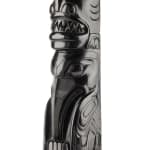-
Artworks
UNIDENTIFIED HAIDA ARTIST
Model Hollow Back Totem Pole, 1860argillite, 20.75 x 3 2.75 in (52.7 x 7.6 cm)LOT 119
ESTIMATE: $15,000 — $25,000
PRICE REALIZED: $14,400.00Further images
A shark or dogfish, with its tail up and the head down and turned upward, a raven with folded wings and an upturned tail, and a sitting beaver at the...A shark or dogfish, with its tail up and the head down and turned upward, a raven with folded wings and an upturned tail, and a sitting beaver at the bottom populate this large argillite totem. The beaver holds a stick across its chest, the textured tail upturned over its belly. The stick and tail, along with the prominent incisors that extend to the lower lip, are long-honored traditional features in Haida and other Northwest Coast cultures. The hollowed back of the pole emulates the hollowed backs of full-sized Haida totem poles. With the backs hollowed out the poles are lighter to facilitate their raising, and they can dry out more evenly as seasonal humidity waxes and wanes, thereby avoiding deep cracks or checks in the drying. The tradition transferred to model poles when they were first conceived in roughly the 1870s, (which also contributed to lightening the stone models) and continued for a period of time, before being dropped in favor of a plain flat back on successive argillite model poles. This pole, like many of its time, has an integral base, a minimal form that is only a little bit wider than the pole itself, and yet provides a solid bottom on which the beaver is poised. The profile view of the model shows how the figures are generally not protrusive, but like its wooden counterparts, are contained within a cylindrical form, the trunk of a cedar tree. As a result, the pole is wider than it is deep.
Steven C. Brown
References: See the section on early model poles in Peter L. Macnair and Alan J. Hoover, The Magic Leaves: A History of Haida Argillite Carving, (Victoria: Royal British Columbia Museum, 2002), pp. 77-89. See also Leslie Drew and Douglas Wilson, Argillite: Art of the Haida, (Vancouver: Hancock House Ltd., 1980), pp. 217-227.Provenance
Private Collection, USA;
A Vancouver Collection.
Join our mailing list
* denotes required fields
We will process the personal data you have supplied in accordance with our privacy policy (available on request). You can unsubscribe or change your preferences at any time by clicking the link in our emails.












